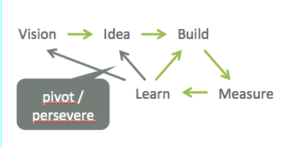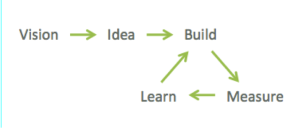Sometimes product managers are tempted to enviously look back to the good old times of waterfall. The world was still simple and easy. Product managers sat at their desks, documenting their plan in a PRD, then handed it over to the developers and before long the next PRD was written. In the meantime one was bothered every now and then with some detailed questions and was looking forward to seeing the project going live after 3 years (more or less).
Today, it is hardly possible to follow the rapid development of agile product management. If with Scrum you were ahead of the bell curve until lately, pitifully looking down on waterfall, today no project seems to be reasonable, if it is not done with Lean Startup applied.
On one hand this development is extremely exciting, since in the last years fundamental principles of a whole industry have been changed. And the journey is not even close to an end. On the other hand these changes and trends can easily lead to confusion in practice. It even gets dangerous when agile approaches are only halfway understood and randomly switched following the general trends. True is that there is not only ONE agile world. In companies there are quite different tasks to be found which need to be tackled in different ways. In the following we present a simple scheme for distinguishing projects in order to choose the “right amount of agility”.
According to Cynefin by David Snowden also in product development complicated and complex environments can be differentiated . An environment is complicated when the relation between cause and effect is clear from the start. Contrary, in complex environments cause/effect relation is not known and can be analyzed ex post at best. In a complicated environment an prediction on the effect of a change in A will have on B. This not possible in complex environments. In the complex domain, the only chance to come closer to the desired state of B is the use of heuristics. If in doubt, several variables A need to be changed rapidly and systematically to evaluate their impact on B afterwards. This is the very core of all agile approaches: Effective learning through rapid and instant feedback.
Startups are an extreme form of complex environments. In startups not only cause/effect of manageable variables is unclear, but also the underlying idea and vision is insecure. So it is not only unclear, whether the solution is right, but also whether a viable customer problem is addressed in the vision. Accordingly, next to the agile build/measure/learn cycle for testing measures also idea and vision need to be validated. This combination of both is the core of Lean Startup:
In contrast to a startup an established successful company with a scaling business model does not need to question vision and idea anymore, because the level of complexity is much lower. To optimize a product that is based on an already validated vision/idea, agile learning in a build-measure-learn cycle is sufficient:
But note that the way of agile learning is limited at some point. The business model can be improved, but in this mode real innovations are not possible. Thus, every company needs to intentionally search for and step into highly complex (or even chaotic) environments on a regular basis (if not continuously) to trigger innovation that again can be pushed back down into the complex domain over time. In other words: Every company needs to generate startups on a regular basis.
With agile development and Lean Startup spreading, it is easily overlooked that in almost every company other vital things are developed that are “only” complex. Here it is totally clear what happens to B, if A is changed. For example it is sure which tracking parameters can be measured, when a specific tracking technology will be implemented. Uncertainty is then limited to technical questions so that it is not reliably predictable how much effort is behind each task. This technical uncertainty is still high, making such things still complicated and not easy. However, in order to cope with this uncertainty it is sufficient to do agile planning with a linear model to keep effort and benefit in a reasonable relation:
Conclusion: Successful companies are and should be in complicated, complex and highly complex/chaotic environments at the same time and should master and chose their weapons accordingly.
Photo by adam fletcher on flickr under CC License




